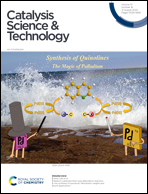New possibility of hydroxyapatites as noble-metal-free catalysts towards complete decomposition of volatile organic compounds
Abstract
We have previously reported the effective catalytic decomposition of volatile organic compounds (VOCs) using stoichiometric hydroxyapatite (HAp), making it the most promising alternative catalyst to replace the expensive conventional noble-metal nanoparticles for VOC purification. Here we derive a catalysis mechanism by exploring HAps with various Ca/P molar ratios (1.70, 1.67, 1.57, 1.37) for the catalytic decomposition of VOCs (ethyl acetate, isopropanol, acetone). In particular, the mechanism is discussed with respect to the particle morphology, specific surface area, crystallinity, chemical structure, radical generation, in situ VOC adsorption properties and acidic/basic site population of HAps combined with confirmation of decomposed by-products in different VOCs. The achieved nearly complete decomposition (98.04%) of VOCs and the initially established catalysis mechanism demonstrated in this work not only provide principle information for catalysis science and technology, but also open a new possibility for the design of noble-metal-free catalysts towards environmental cleaning.



 Please wait while we load your content...
Please wait while we load your content...